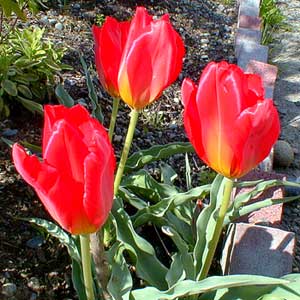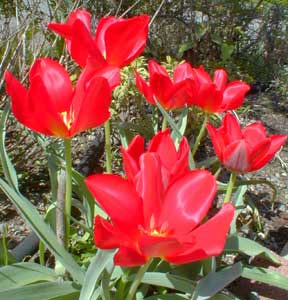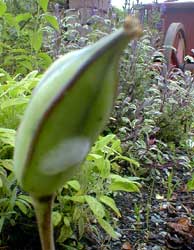 | |
|
Guarded within the old red wall's embrace, Marshalled like soldiers in gay company, The tulips stand arrayed. Here infantry Wheels out into the sunlight. What bold grace Sets off their tunics, white with crimson lace! Here are platoons of gold-frocked cavalry, With scarlet sabres tossing in the eye Of purple batteries, every gun in place. Forward they come, with flaunting colours spread, With torches burning, stepping out in time To some quick, unheard march. Our ears are dead, We cannot catch the tune. In pantomime Parades that army. With our utmost powers We hear the wind stream through a bed of flowers. -A Tulip Garden | |
Vvedensky's Tulip
Tulipa vvedenskyi is named for the Russian botanist Aleksej Ivanovic Vvedensky (1898-1972) who did significant research on the flora of Uzbekistan, where this botanical tulip originated. Professor Vvedensky was the author of the landmark work on Central Asian tulips, Flora of the USSR (1968).
Somewhat uncommon in the tulip trade, Vvendensky's Tulip is available only from species specialists. The unusual "double-V" spelling is sometimes improperly changed so that it is listed as Wedenskyi's Tulip.
We'll eventually plant more bulbs for this one, as the few bulbs we planted in 2002 turned out to be really stunning tulips of an extravagantly deep red, & had already multiplied in number by 2004.
Even their grey-green wavy nearly prostrate octopus-foliage is interesting. We planted them along the sidewalk in a low-maintenance sun-garden, where they are in full flower for April, shown in April photos from 2003 (top) & 2004 (second).
On overcast days the flowers are semi-folded, revealing the silvered dusting of the outer petals. When the sun is bright, the flowers fluff out a great deal, so that mostly only the pure red of the interior petals shows, & a small yellow eye in the bottom.
At full flower they are eight or ten inches tall, & four or five inches of that height is just the bright petals, which become shorter when fully opened in bright midday sun. They reclose in late afternoon.
 There are a couple of cloned cultivars on the market (i.e., 'Orange Sunset' & 'Tangerine Beauty') but ours is the original wild form.
There are a couple of cloned cultivars on the market (i.e., 'Orange Sunset' & 'Tangerine Beauty') but ours is the original wild form.Some generalities about species tulips apply equally to this one. While fancy tulip cultivars tend to weaken year by year, species tulips will become stronger & more numerous over the years, so it is really worth caring for them properly. They should not be too quickly cut back when they are done blooming, as the leaves will continue to develop for some while, fattening the bulbs. The leaves can be removed when they are browning; or they can be permitted to decay into the soil without being clipped back at all, though the tidiest gardeners may not be able to let them do so.
It is a good idea to deadhead spent blossoms, however, so that the energy will be expended on creating a larger stronger bulb, with offsets, rather than on seeds (the third photo shows a seedpod in late May). Nitrogen fertilizer generally is not required, but a potash feed shortly after bloom is a good idea for most bulbs.
 When botanical tulips have completely vanished in summer, they are not in truly dormant, & should not dry out entirely; they are bulking up the bulbs & producing new roots to sustain the following year's flower. For T. vvedenskyi, however, they are native to regions noted for summer drought, so the least residual moisture in summer will be plenty for these.
When botanical tulips have completely vanished in summer, they are not in truly dormant, & should not dry out entirely; they are bulking up the bulbs & producing new roots to sustain the following year's flower. For T. vvedenskyi, however, they are native to regions noted for summer drought, so the least residual moisture in summer will be plenty for these.In winter botanicals are much more at risk of damage if too wet while dormant. There is no stopping winter rainfall, however, so soils should be extremely well draining. In our mild zone where mulching is not required, a mulch of large maple leaves or big fern fronds from elsewhere in the garden can "barrier" the soil somewhat against too much wetness reaching the resting tulip bulbs.
Since there is no sign of the tulips when they are out of season, the area must be well marked, so that they will not be accidentally disrupted. Tulips do not like to be lifted, & if it is ever necessary to dig them up, it should be just before the leaves have died back completely, & they should be replanted instantly without drying out.
T. vvedenskyi may fail to thrive outside of zones five to eight. In warmer climates, the area of the bulbs will need to be mulched in summer so they will not become baked.